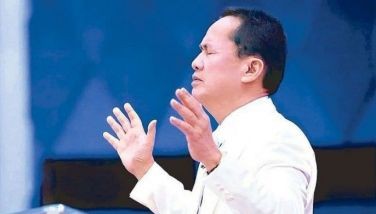Electricity, water supply woes haunt K to 12
MANILA, Philippines – The Department of Education (DepEd) will offer senior high school programs in hundreds of existing high schools that do not have access to electricity or water supply, a research conducted by The STAR revealed.
Analysis of latest available data from the agency showed that 97 senior high schools will be established in high schools that have no electricity, while another 250 will be built on existing institutions that have no access to water supply.
Most of the schools are located in Mindanao, particularly in CARAGA and in the Autonomous Region in Muslim Mindanao.
Sought for comment, DepEd Secretary Armin Luistro admitted that there are senior high schools that will be established in areas that are unenergized or unserviced by local water districts.
“Obviously, learning is enhanced when you have electrical power and water supply, but schools will have to be established even in the most remote communities as long as there are young people who need to be reached,” Luistro said.
“In the implementation of the K to 12 program, DepEd has endeavored to ensure that senior high school programs are accessible even in hard-to-reach communities,” he added.
The number of schools without access to electricity and water supply was based on datasets uploaded on the DepEd website, which showed the status of electricity and water supply of public schools in the country as of School Year 2013-2014.
It was correlated with the list of 5,898 public senior high schools that will start offering Grade 11 in 2016 and Grade 12 in 2017.
The STAR made requests for updated data, but the agency has yet to release the said information as of press time.
The same dataset on access to electricity was used by the agency when it launched a campaign in August aimed at providing solar-powered lamps to unenergized schools.
No electricity
DepEd data showed that 5,421 of over 36,000 elementary schools across the country have no electricity. Another 315 high schools, out of over 7,500 public high schools, are also unenergized.
From the list of public schools without access to electricity, 97 have already been identified by DepEd as those that will offer Grades 11 and 12 in the next two years.
More than half of the senior high schools that do not have access to electricity are in Mindanao.
According to Luistro, DepEd is working with various partners in order to provide solar panels or electrical connections not just in unenergized senior high schools, but in all public schools that have no access to electricity.
In August, during the launch of the LightEd PH campaign, Luistro gave a commitment that the agency and its partners will work toward energizing all schools before the start of the next school year.
DepEd has partnered with the National Electrification Administration (NEA) and the Department of Energy (DOE) to provide solutions through conventional and alternative sources of energy, Luistro said.
In a memorandum of understanding with DepEd, NEA pledged to build its new posts near unenergized schools that are already in areas on the grid, or those within the grid supply of electric cooperatives.
Luistro said they also requested the DOE to establish alternative energy hubs near or within schools in off-grid areas.
No water supply
Meanwhile, latest available DepEd data showed that 4,583 elementary schools and 518 high schools across the country have no available water supply.
These are schools that are not connected to local pipes or do not have deep well, rainwater catchment or a natural source of water for the students, teachers and school officials.
Out of the over 5,000 schools that have no access to water, a total of 250 have been identified as those that will offer senior high school programs.
Almost half of the said senior high schools are in Mindanao.
Luistro said the agency is in close coordination with the respective municipalities or city water districts in order to provide the schools with access to clean water.
He also noted plans to construct water catchment facilities that are included in the new school building designs of the Department of Public Works and Highways.
“There are many ongoing interventions of DepEd with our partners to address those needs,” Luisto added.
K to 12 program
Starting 2016, the government will implement the senior high school program, the most integral aspect of the Enhanced Basic Education Act of 2013 – commonly known as the K to 12 Law – which seeks to add two years to basic education in the country.
The Aquino administration has poured billions in funding to DepEd in preparation for the senior high school program.
For 2016, DepEd has a proposed budget of P432.918 billion, up from the current P319.231 billion.
This includes a proposal of P80 billion for the construction of over 43,000 new classrooms for the implementation of Grade 12 in June 2017.
Luistro said the budget for the construction of 43,000 classrooms for Grade 11 has already been lodged in the 2014 and 2015 budgets.
Another P19.322 billion was set aside for the hiring of new teachers, while over P12 billion will be used to subsidize the tuition of public Grade 10 graduates who will choose to enroll in private senior high schools.
The expected displacement of college faculty, along with allegations that the government is not ready to implement the program, was the basis of several cases filed against the flagship education program of the current administration before the Supreme Court.
Luistro, however, maintains that the government is on track with the implementation of K to 12.
“Discussions on whether we are ready or not is over. It is time to simply act on an educational reform we should have done many decades ago,” he told The STAR in an earlier interview.
“The budget for 2015 and 2016 includes all the other essential inputs of teachers, equipment and resources. We call on everyone to help us and contribute constructively as we prepare for the opening of our Grade 11 classes by June 2016,” he added.
Under the senior high school program, students will have the option to choose between four tracks: academic, sports, arts and design, or technical-vocation-livelihood.
“With K-12, we are making sure that adequate and useful skills are being imparted to our students,” President Aquino said after signing the law in 2013.
“The additional two years after fourth year high school are intended to further hone the skills and talents of students for their chosen career path in arts and sports, technical vocational, entrepreneurship or tertiary education,” the President said.
(This report is the output of a team of Philippine STAR journalists who took part in the Data Journalism Philippines 2015 training program organized by the Open Knowledge Foundation and the Philippine Center for Investigative Journalism.)
- Latest
- Trending





























